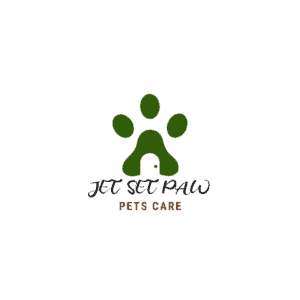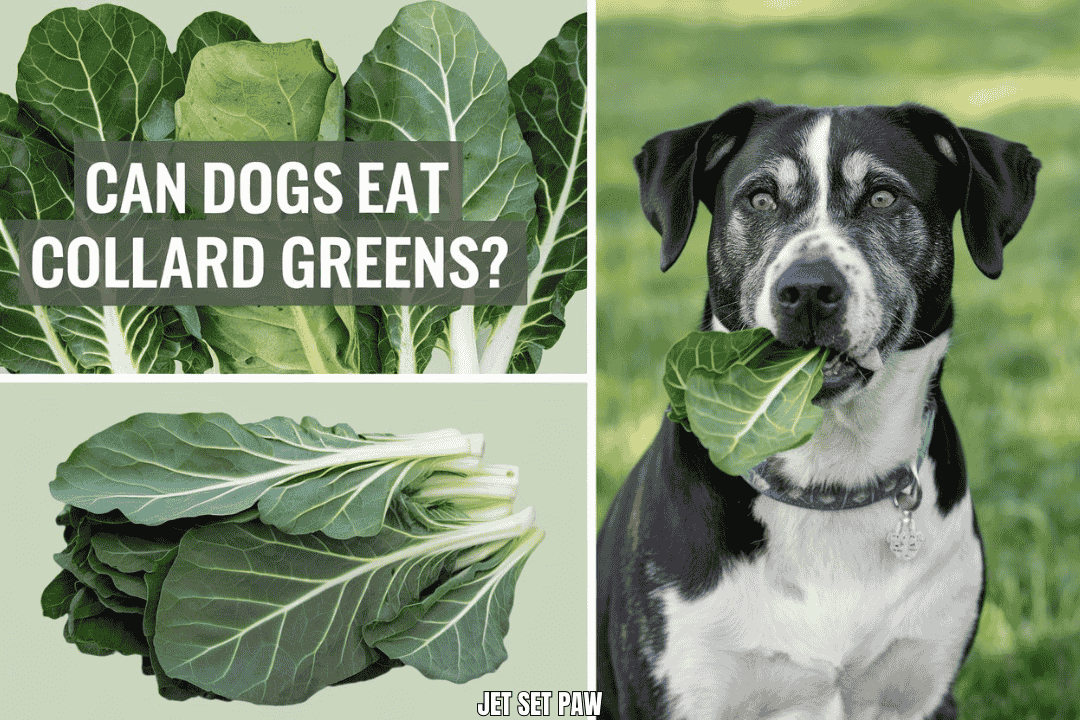Collard greens are a type of leafy green vegetable in the same family as kale and broccoli. They’re known for their large, dark green leaves and slightly bitter taste.
Collard greens are popular in many cuisines, especially in the southern United States, where they’re often cooked with meat or served as a side dish.
As a dog owner, knowing which foods are safe for your furry friend is crucial. Dogs have different digestive systems than humans, and some foods that are perfectly fine for us can be harmful or even toxic to them.
That’s why it’s essential to research before sharing any human food with your pet. By understanding what dogs can and can’t eat, you can keep your four-legged companion healthy and avoid potential trips to the vet.
Knowing which foods are safe can help you add some variety to your dog’s diet and give them new, tasty treats.
The Short Answer
Good news for dog owners who share their veggies: dogs can eat collard greens! But like many things in life, moderation is key.
While giving your furry friend some collard greens is okay, they shouldn’t become a significant part of their diet. Think of them as an occasional treat or a small addition to their regular meals.
It’s also important to know that collard greens are not toxic to dogs. This means you don’t have to panic if your pup sneaks a few bites off your plate or finds some in the garden.
Unlike some foods that can be dangerous for dogs, like chocolate or grapes, collard greens won’t cause poisoning or severe health issues. However, this doesn’t mean you should let your dog eat as much as they want.
Too much new food can upset a dog’s stomach, so it’s always best to introduce collard greens slowly and in small amounts.
Benefits of Collard Greens for Dogs
Collard greens aren’t just tasty; they’re a nutritional powerhouse for your dog. These leafy greens are like a natural multivitamin, containing several vital nutrients to boost your pup’s health.
First off, collard greens are rich in vitamins. They’ve got plenty of Vitamin A, which helps keep your dog’s eyes healthy and their immune system strong.
There’s also Vitamin C, which acts as an antioxidant and can help fight off illness. And don’t forget about Vitamin K, vital for blood clotting and strong bones.
But that’s not all! Collard greens also contain minerals that dogs need. They’re a good source of calcium, which is essential for strong teeth and bones.
Iron is another mineral found in these greens, and it helps your dog’s body make red blood cells, which carry oxygen around the body.
Another big plus of collard greens is their fiber content. Fiber is excellent for keeping your dog’s digestive system running smoothly.
It can help prevent constipation and even make your dog feel fuller, which is helpful if your dog is trying to lose a few pounds.
Speaking of weight, collard greens are a low-calorie snack option for dogs. If you’re looking for a healthy treat that won’t add extra pounds to your pup, these greens are a good choice.
They can satisfy your dog’s urge to munch without packing on the calories like some store-bought treats might.
In short, collard greens offer a bunch of health benefits for dogs when given in moderation. They’re like a little green powerhouse of nutrition, and it’s up to you to ensure your dog enjoys them safely and responsibly!
Potential Risks and Concerns
While collard greens can be good for dogs, there are some risks to consider. Knowing these potential issues is essential to keep your furry friend safe and healthy.
One of the main concerns with feeding collard greens to dogs is digestive issues. Some dogs might get gassy after eating these greens.
This is because collard greens contain certain compounds that can be hard for dogs to digest. If you notice your dog is experiencing digestive issues, such as excessive gas or bloating, after eating collard greens, it’s best to stop feeding them to your dog and consult your vet.
Another risk to consider is the choking hazard. Collard greens have tough stems and large leaves that can be difficult for dogs to chew correctly.
They could choke if your dog tries to swallow large pieces without chewing. This is especially true for smaller dogs or those who eat quickly without chewing much.
Lastly, there’s the issue of pesticides and chemicals. If you’re not using organic collard greens, they might have been treated with pesticides or other chemicals to keep bugs away.
These substances can be harmful to dogs if eaten. To avoid this, always opt for organic collard greens. Even if you wash the greens, some chemicals might still be present, so it’s best to be cautious.
By being aware of these potential risks, you can minimize them and ensure your dog enjoys collard greens safely.
How to Safely Feed Collard Greens to Dogs
If you want to feed your dog collard greens, it’s essential to prepare them properly. Start by washing the greens thoroughly.
Rinse them under cool water and gently scrub the leaves to remove dirt or chemicals. This step is crucial to ensure your dog doesn’t ingest harmful substances.
After washing, you’ll need to cook the collard greens. The best method is steaming, which keeps most nutrients intact. Steam the leaves for 5-7 minutes until tender but still slightly crisp.
You can also boil them briefly, which might cause some nutrient loss. Avoid using oils, butter, or seasonings, as these can harm dogs.
When it comes to serving size, start small. For medium to large dogs, offer just one or two small leaves. If you have a small dog, use only a portion of a leaf.
You can slowly increase the amount if your dog handles it well. Remember, collard greens should make up no more than 10% of your dog’s daily diet.
As for how often to feed collard greens, begin by offering them once or twice a week. Watch how your dog reacts and adjust accordingly.
If there are no digestive issues, you can offer them more frequently. However, it’s best to keep collard greens as an occasional treat rather than a daily food item.
Always introduce new foods slowly and watch for any bad reactions. If you notice any stomach problems or unusual behavior after feeding collard greens to your dog, stop giving them to it and talk to your vet.
It’s important to monitor your dog’s reaction to new foods, including collard greens, to ensure they are safe and comfortable.
Other Vegetables Safe for Dogs
Dogs can enjoy a variety of vegetables besides collard greens. Knowing about these options to add variety to your pet’s diet is good. Here’s a quick look at some dog-friendly veggies and how they compare to collard greens.
Quick list of dog-friendly veggies:
Many vegetables are safe for dogs to eat. Some popular choices include carrots, green beans, sweet potatoes, pumpkin, and broccoli. Carrots are crunchy and full of vitamin A. Green beans are low in calories and fiber.
Sweet potatoes and pumpkin are excellent sources of vitamins and can help with digestion. Broccoli is packed with nutrients but should be given in small amounts.
Comparison to collard greens:
Collard greens are unique among these vegetables in a few ways. They have more calcium than most dog-friendly veggies, which improves bone health. However, they also contain compounds that can cause gas, which isn’t a big issue with carrots or green beans.
Regarding preparation, collard greens must be cooked before feeding to dogs. This differs from carrots, which can be given raw as a crunchy snack. Sweet potatoes should be cooked like collard greens, but they’re often easier for dogs to digest.
Collard greens are leafy and can be more challenging for some dogs to eat compared to the shape and texture of green beans or small broccoli florets. However, all these vegetables should be cut into small, manageable pieces for your dog.
Remember, while these vegetables are safe for dogs, they should all be given in moderation as part of a balanced diet. Always introduce new foods slowly and watch for any unusual reactions.
Conclusion
In this section, we’ll recap what we’ve learned about feeding collard greens to dogs and stress some essential points to remember.
We’ve covered a lot of information about collard greens and dogs. First, we learned that collard greens can be a healthy treat for dogs when appropriately given.
They contain vitamins and minerals that can benefit your pet’s health. However, we also found out that there are some risks, like possible digestive issues, if fed in large amounts.
We discussed how to prepare collard greens safely by washing them well and cooking them without added fats or seasonings. We also discussed serving sizes, suggesting small amounts and not making collard greens more than 10% of your dog’s diet. Lastly, we looked at other safe vegetables for dogs and how they compare to collard greens.
Remember moderation when feeding your dog any new food. Even healthy foods like collard greens should be given in small amounts. Too much of a good thing can still cause problems for your pet.
Equally important is talking to your veterinarian before making any significant changes to your dog’s diet. Every dog is different, and what works for one might not work for another. Your vet knows your dog’s health history and can give personalized advice.
Your vet can help you decide if collard greens suit your dog. They can also guide you on how much to feed and how often. If your dog has health issues, your vet might suggest other vegetables that suit your pet’s needs.
In conclusion, while collard greens can be a healthy addition to your dog’s diet, it’s best to approach them with caution and knowledge.
By being informed and working with your vet, you can make sure you’re making the best choices for your furry friend’s health and happiness.

